Veterinary universities can play a significant role in strengthening Extension and Advisory Services (EAS) provision to livestock owners. In this meeting note, Drs. D Sreenivasulu, J Suresh, N Sailaja, G Triveni, and D Srinivasa Rao illustrate how the Sri Venkateswara Veterinary University (SVVU), Tirupati, Andhra Pradesh, is engaged in strengthening EAS provision in the state of Andhra Pradesh.
CONTEXT
The question usually raised is, “What is the role that veterinary universities have to play in promoting livestock extension in a state?” Many veterinary universities have two arms: namely Directorate of Extension (DE), and Continuing Veterinary Education and Communication (CVEC) to reach livestock, poultry and fish farmers. Unfortunately, the impact of these two wings has not gone beyond adoption of a few nearby villages, which is primarily due to the assumption that promoting livestock extension is the State Department of Animal Husbandry. The university usually operates in a water tight compartment with focus on teaching and research activities, with little or no coordination with other stakeholders of livestock development. However, veterinary universities can play a significant role through its Directorate of Extension and Centre for Continuous Veterinary Education and Communication in extending Extension and Advisory Services to the livestock owners as contended by Dr D. Sreenivasulu and others of Sri Venkateswara Veterinary University (SVVU), Tirupati, Andhra Pradesh.
STAKEHOLDER WORKSHOP
 SVVU, like many other veterinary universities, has been facing a challenge with regard to improving its image as a promoter of livestock extension among livestock owners. To address this issue, SVVU had organised a one-day state level workshop at Tirupati on 4 July, 2017 (Box 1).
SVVU, like many other veterinary universities, has been facing a challenge with regard to improving its image as a promoter of livestock extension among livestock owners. To address this issue, SVVU had organised a one-day state level workshop at Tirupati on 4 July, 2017 (Box 1).
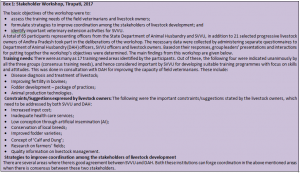
RESPONSE TO WORKSHOP OUTCOMES
Training field veterinarians and farmers
An innovative programme entitled, “Rythu Sikshana Patham – Pasu Vaidya Viswa Vidyalayam” under the caption “Mee Kosam – Mee Sevalo”, was launched by the Centre for Continuing Veterinary Education & Communication (CCVEC), SVVU, to reach livestock farmers and field veterinarians of the entire state. This can help in ascertaining their area-specific problems pertaining to livestock, and disseminate knowledge on the latest livestock production technologies. The first such programme was launched at Anantapur district by the Hon’ble Vice-Chancellor, Dr. Y Hari Babu. This district being highest in sheep population, training programmes were conducted in all the five divisions of Anantapur by identifying the respective sheep pockets from 8-10 November, 2017. The Joint Collector, a few members, Board of Management (BOM), SVVU, and senior officials of the DAH and Sheep Development Project took part in these events.
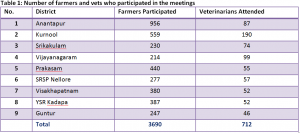 Training sessions were conducted on best feeding, breeding, and management practices for sheep. Simultaneous sessions were conducted for the field veterinarians and area-specific problems/issues faced by them were identified. Veterinarians were trained on differential diagnosis of sheep diseases, importance of flushing ewes during breeding season, vaccination schedules to be followed, use of mobile apps developed by SVVU on ration balancing programme, etc. Later the program was extended to eight other districts of Andhra Pradesh, covering 3690 farmer beneficiaries and 712 field veterinarians.
Training sessions were conducted on best feeding, breeding, and management practices for sheep. Simultaneous sessions were conducted for the field veterinarians and area-specific problems/issues faced by them were identified. Veterinarians were trained on differential diagnosis of sheep diseases, importance of flushing ewes during breeding season, vaccination schedules to be followed, use of mobile apps developed by SVVU on ration balancing programme, etc. Later the program was extended to eight other districts of Andhra Pradesh, covering 3690 farmer beneficiaries and 712 field veterinarians.
Capacity development of shepherds
In most of the districts, the focus was on sheep development as the shepherds were unable to take advantage of scientific technologies. The basic veterinary needs of shepherds were neglected by government agencies, such as providing basic technical inputs like vaccines and medicines. In addition, there is no organised market for the sale of live sheep and hence shepherds were vulnerable to exploitation by middlemen.
Training shepherds on scientific management of sheep
In these meetings the main problems expressed by the shepherds were: high lamb mortality, poor growth of lambs, and poor availability of veterinary services. The experts gave lectures on reasons for high lamb mortality, such as inbreeding, poor feeding of pregnant ewes, inadequate milk from the ewes to feed the lambs, and methods to reduce the incidence of lamb mortality. The experts also tried to address these issues with focus on relevant technologies/practices.
Promoting ram exchange
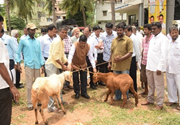 The major problem in sheep rearing is inbreeding. The shepherds have a tendency to use same ram(s) for breeding in the flock for more than seven to eight years leading to inbreeding, which results in low birth weight of lambs, abortions, weak lambs, high incidence of lamb mortality, poor growth, etc. It is necessary for the shepherds to change the breeding rams at least once in two years so as to avoid inbreeding among the sheep. This could be done either by selling the breeding ram and purchasing a new one in the shandy, or exchanging breeding rams among the shepherds of different villages. Although scientists and extension agents recommend changing the breeding rams, the shepherds have not been adopting this practice.
The major problem in sheep rearing is inbreeding. The shepherds have a tendency to use same ram(s) for breeding in the flock for more than seven to eight years leading to inbreeding, which results in low birth weight of lambs, abortions, weak lambs, high incidence of lamb mortality, poor growth, etc. It is necessary for the shepherds to change the breeding rams at least once in two years so as to avoid inbreeding among the sheep. This could be done either by selling the breeding ram and purchasing a new one in the shandy, or exchanging breeding rams among the shepherds of different villages. Although scientists and extension agents recommend changing the breeding rams, the shepherds have not been adopting this practice.
 SVVU has utilised the interactive meeting to showcase benefits arising from ram exchange by organising a Breeding Ram Show. Most of the shepherds were convinced and started exchanging the rams among themselves. The difference in the weight or appearance or age of rams was suitably negotiated among the shepherds themselves. This programme has been quite a success in almost all the villages where the interaction meetings were organised for the benefit of shepherds. In Guntur district alone, more than 100 rams took part in the competition and most of them were exchanged.
SVVU has utilised the interactive meeting to showcase benefits arising from ram exchange by organising a Breeding Ram Show. Most of the shepherds were convinced and started exchanging the rams among themselves. The difference in the weight or appearance or age of rams was suitably negotiated among the shepherds themselves. This programme has been quite a success in almost all the villages where the interaction meetings were organised for the benefit of shepherds. In Guntur district alone, more than 100 rams took part in the competition and most of them were exchanged.
Feeding of pregnant ewes
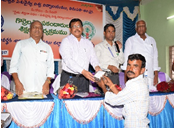 The shepherds usually follow extensive grazing in the open fields and do not feed concentrates to their sheep (almost zero cash cost on feeding). The sheep must be given concentrates to improve their weight faster. Similarly, the pregnant ewes must be given concentrates, especially in the last two months of pregnancy, to enable them to deliver healthy lambs and to give enough milk to the suckling lambs. Although this feeding practice has been recommended, most of the shepherds are not adopting it, mainly because of the cash cost involved in purchasing the feed and inability to realise its benefits. The Managing Director of the Sheep Development Federation who also took part in the meetings has agreed to supply the concentrates through its Sheep Producer’s Cooperative Societies on subsidy so as to encourage shepherds to cultivate the habit of feeding concentrates to their sheep.
The shepherds usually follow extensive grazing in the open fields and do not feed concentrates to their sheep (almost zero cash cost on feeding). The sheep must be given concentrates to improve their weight faster. Similarly, the pregnant ewes must be given concentrates, especially in the last two months of pregnancy, to enable them to deliver healthy lambs and to give enough milk to the suckling lambs. Although this feeding practice has been recommended, most of the shepherds are not adopting it, mainly because of the cash cost involved in purchasing the feed and inability to realise its benefits. The Managing Director of the Sheep Development Federation who also took part in the meetings has agreed to supply the concentrates through its Sheep Producer’s Cooperative Societies on subsidy so as to encourage shepherds to cultivate the habit of feeding concentrates to their sheep.
Screening of rams for brucellosis
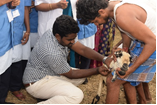 SVVU has taken up the initiative of collecting blood samples from the rams brought for competition and screened for brucellosis. Fortunately, not a single ram was found positive for brucellosis. This practice of screening these rams for brucellosis has been taken up by the Department of Animal Husbandry and also by the State Level Diagnostic Laboratory, Tirupati.
SVVU has taken up the initiative of collecting blood samples from the rams brought for competition and screened for brucellosis. Fortunately, not a single ram was found positive for brucellosis. This practice of screening these rams for brucellosis has been taken up by the Department of Animal Husbandry and also by the State Level Diagnostic Laboratory, Tirupati.
Containing anthrax outbreak
 The DAH has sought the help of SVVU in controlling anthrax outbreak in a tribal area (Paderu) of Visakhapatnam district. An interactive meeting was organised in Paderu to educate the shepherds on control of various diseases which affect sheep. Focus was on anthrax which is of zoonotic importance, and the shepherds were advised to get their sheep vaccinated against anthrax regularly every year, and precautions to be taken in proper disposal of the sheep that have died of anthrax. It is not uncommon to notice in these tribal areas that the shepherds dry the carcass and later consume the meat for several days. This is the practice going on since several decades mainly because of their ignorance. Hence, SVVU educated the farmers on not consuming the meat of dead sheep in order to avoid infection (cutaneous and gastrointestinal problems) that are being reported regularly.
The DAH has sought the help of SVVU in controlling anthrax outbreak in a tribal area (Paderu) of Visakhapatnam district. An interactive meeting was organised in Paderu to educate the shepherds on control of various diseases which affect sheep. Focus was on anthrax which is of zoonotic importance, and the shepherds were advised to get their sheep vaccinated against anthrax regularly every year, and precautions to be taken in proper disposal of the sheep that have died of anthrax. It is not uncommon to notice in these tribal areas that the shepherds dry the carcass and later consume the meat for several days. This is the practice going on since several decades mainly because of their ignorance. Hence, SVVU educated the farmers on not consuming the meat of dead sheep in order to avoid infection (cutaneous and gastrointestinal problems) that are being reported regularly.
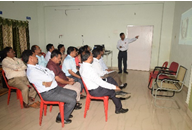 The field vets were given tips on prevention and control of this disease. Emphasis was laid on the factors responsible for vaccine failures. Advice was provided on how to carry out disposal of the carcass scrupulously as it is essential to break the cycle of infection. Burning and burial are the general recommended practices for disposal of a carcass. If they are not feasible due to economic constraints it is emphasized that the carcass not be opened, since putrefaction destroys the causative organisms. However, the carcass needs to be protected from predators. It is also advised to vaccinate all the susceptible animals in the area annually, and not to use antibiotics immediately after vaccination to avoid vaccine failures. The Joint Commissioner of Tribal Sub Plan in the area took special interest in controlling this disease.
The field vets were given tips on prevention and control of this disease. Emphasis was laid on the factors responsible for vaccine failures. Advice was provided on how to carry out disposal of the carcass scrupulously as it is essential to break the cycle of infection. Burning and burial are the general recommended practices for disposal of a carcass. If they are not feasible due to economic constraints it is emphasized that the carcass not be opened, since putrefaction destroys the causative organisms. However, the carcass needs to be protected from predators. It is also advised to vaccinate all the susceptible animals in the area annually, and not to use antibiotics immediately after vaccination to avoid vaccine failures. The Joint Commissioner of Tribal Sub Plan in the area took special interest in controlling this disease.
 Fertility camps to address repeat breeding in cows and buffaloes
Fertility camps to address repeat breeding in cows and buffaloes
This was a major problem according to the farmers in Chittoor and Guntur districts. Fertility campaigns were organised in two villages (one in each district) and the cases were treated as per the diagnosis under the supervision of the experts from SVVU. The concerned field veterinarian was involved in the process to manage the treatment protocol. Totally 52 cases were examined by the experts and the respective local veterinarians followed up the cases..
Screening for sub clinical mastitis
Usually the cases of mastitis are identified when the symptoms start appearing, but by that time it is too late to initiate the treatment. Identifying the appropriate antibiotic to be used based on antibiotic sensitivity test is cumbersome and time consuming. The field vets usually resort to a trial-and-error method based on their experience, so in most of the cases the treatment will not be successful, and the affected teats may become blind and finally the cow will end up in a slaughter house. This problem could be resolved to a great extent by screening the milking animals for sub-clinical mastitis (before the symptoms appear) at farmers’ level. This method of screening needs to be simplified to enable the farmers to do it themselves rather than depending on vets or para-vets.
 SVVU along with the State Department of Animal Husbandry launched a ‘Mastitis Control Programme’ on a pilot basis with the objectives of creating awareness among dairy farmers about the economic impact of mastitis; demonstrate and train the farmers on methods for detection of sub-clinical mastitis; methods like pre-dip and post-dip of teats for control of mastitis, and management practices to prevent mastitis. The dairy farmers were shown an A-V (module) prepared on Mastitis Control, and a practical demonstration was conducted on detection of mastitis.
SVVU along with the State Department of Animal Husbandry launched a ‘Mastitis Control Programme’ on a pilot basis with the objectives of creating awareness among dairy farmers about the economic impact of mastitis; demonstrate and train the farmers on methods for detection of sub-clinical mastitis; methods like pre-dip and post-dip of teats for control of mastitis, and management practices to prevent mastitis. The dairy farmers were shown an A-V (module) prepared on Mastitis Control, and a practical demonstration was conducted on detection of mastitis.
 After the video show the faculty of SVVU gave a demonstration to the farmers on the simplified method to screen cows. The farmers were supplied with a reagent (2% Surf Excel, a detergent, rather than the usual mastoid solution used in the California mastitis test) and a plastic paddle with four cups (available in local markets). The farmers followed the method under the supervision of vets to detect sub-clinical mastitis in their milch cows. Twelve farmers milked their animals in the presence of other dairy farmers which enabled the latter to gain confidence in practicing this method. All the participating farmers were supplied with the reagents and cups necessary for screening the cows. About 100 dairy farmers participated in the programme. Follow-up of the programme was taken up by the local veterinarian.
After the video show the faculty of SVVU gave a demonstration to the farmers on the simplified method to screen cows. The farmers were supplied with a reagent (2% Surf Excel, a detergent, rather than the usual mastoid solution used in the California mastitis test) and a plastic paddle with four cups (available in local markets). The farmers followed the method under the supervision of vets to detect sub-clinical mastitis in their milch cows. Twelve farmers milked their animals in the presence of other dairy farmers which enabled the latter to gain confidence in practicing this method. All the participating farmers were supplied with the reagents and cups necessary for screening the cows. About 100 dairy farmers participated in the programme. Follow-up of the programme was taken up by the local veterinarian.
These programmes had a cascading effect on the district administration which led to SVVU being invited to organise farmers’ meetings in their respective districts. Based on the demand from farmer producer organisations, a training programme was organized by the project director of District Rural Development Agency (DRDA), Anantapur with active participation of SVVU. Smt. Paritala Sunitha, the then Minister for Women & Child Welfare, attended as Chief Guest of the programme. More than 700 participants from farmer producer organisations participated in the programme. The faculty of SVVU enlightened the farmers on scientific breeding, feeding management, and health aspects of livestock. Various livestock activities were displayed in the form of multimedia modules through Pashu Vignana Prachara Vahini (Mobile Veterinary Extension Vehicle) and the same was appreciated by the farmers as well as the Minister.
EXTENSION METHODS TO IMPROVE THE KNOWLEDGE OF FARMERS ON VARIOUS ASPECTS OF LIVESTOCK MANAGEMENT
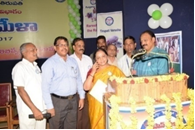 A toll free phone number – 1800-120-4209 – working through IVR solutions was established by SVVU to provide online help to livestock owners in six specific areas: Reproduction, disease control, Production, Management, Fish farming, and Milk & Meat products. This number was widely circulated among the farmers through several methods – printed on all the SVVU extension literature; visiting cards with the number were distributed to farmers in all the meetings; displayed on the mobile extension van. This facility has been used by the farmers to clarify their doubts and to seek information on various aspects of livestock management. So far 2682 farmers have availed of this facility to establish contact with the experts of SVVU.
A toll free phone number – 1800-120-4209 – working through IVR solutions was established by SVVU to provide online help to livestock owners in six specific areas: Reproduction, disease control, Production, Management, Fish farming, and Milk & Meat products. This number was widely circulated among the farmers through several methods – printed on all the SVVU extension literature; visiting cards with the number were distributed to farmers in all the meetings; displayed on the mobile extension van. This facility has been used by the farmers to clarify their doubts and to seek information on various aspects of livestock management. So far 2682 farmers have availed of this facility to establish contact with the experts of SVVU.- Publications, such as Rythupanchangam, calendars, manuals, folders, etc., were distributed to farmers in all the meetings. All these publications and CDs were
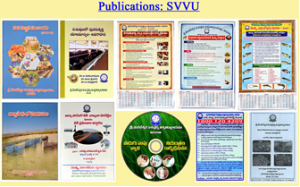 obtainable at the exhibitions organised during farmers’ meetings. These materials are in great demand and in one such meeting more than Rs. one lakh worth of publications/CDs were purchased by the farmers and field vets. This programme has drawn huge applause from the shepherd communities of Ongole.
obtainable at the exhibitions organised during farmers’ meetings. These materials are in great demand and in one such meeting more than Rs. one lakh worth of publications/CDs were purchased by the farmers and field vets. This programme has drawn huge applause from the shepherd communities of Ongole. - Mobile Extension Van: A mobile van specially fabricated with audio and video equipment and facilities for sample collection and screening under the name ‘Pasu Vignana Prachara Vahini’ was introduced. This is the first of its kind in India to reach farmers at their doorsteps. The objective of this mobile unit is to create awareness among villagers; identify problems and provide need-based solutions; provide information on low-cost feed formulations with locally available ingredients, health care, treatment and prophylaxis; and transfer new scientific technologies to the farming community. This vehicle was taken to all the village extension programmes in the state and it has covered m
 ore than 38 villages so far. SVVU has three such vehicles stationed in each of the veterinary colleges for publicity before the start of a programme, and also for screening videos on specific subjects. This vehicle is much sought after by different agencies, including academic institutions in the country.
ore than 38 villages so far. SVVU has three such vehicles stationed in each of the veterinary colleges for publicity before the start of a programme, and also for screening videos on specific subjects. This vehicle is much sought after by different agencies, including academic institutions in the country. - Awareness programme for students on the importance of zoonotic diseases and their control: The activity of Centre for Continuing Veterinary Education and Communication (CCVEC) to create awareness on zoonotic diseases was officially launched on World Zoonosis Day, i.e 6 July, 2018, on the premises of Z.P.H. School, Narasingapuram village, Chandragiri mandal, Chittoor district. The inaugural programme was graced by the Vice-Chancellor and several officials of SVVU, Tirupathi. By the end of February, 2019 the CCVEC has covered 12 Zilla Parishad High Schools around Tirupathi.
In this programme the school children were given awareness on:
- Transmission of diseases from bacteria, virus, parasites, and fungus to humans;
- Importance of vaccination against rabies disease;
- Importance of good eating habits, like drinking pasteurized milk and eating well-cooked meat; and
- Importance of handwashing before and after eating (and drinking) meals.
- Capacity building of field vets, para-vets and farmers: Field veterinarians are recognised as the best sources of information on livestock management, because they are in direct contact with livestock farmers at the village level. In order to improve the skills and competencies of field vets, regular training programmes on latest diagnostic tests, surgical intervention, reproductive management, fodder development and conservation, use of mobile apps developed by SVVU on ration balancing programme, etc., are conducted to update their knowledge level, skill development, and latest technical know-how at knowledge centres of the university, like constituent veterinary colleges, research stations, KVKs, State Level Animal Disease Diagnostic Laboratory (SLDL) and CCVEC.

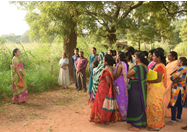 Similarly, Training Programmes are also organized for dairy farmers, shepherds, fishermen, women, unemployed youth, members of self help groups and NGO’s associated with animal husbandry activities in their respective fields of interest, such as management and production aspects of dairy and sheep rearing, awareness on prevention and control of animal diseases, clean milk production, and value addition, etc.
Similarly, Training Programmes are also organized for dairy farmers, shepherds, fishermen, women, unemployed youth, members of self help groups and NGO’s associated with animal husbandry activities in their respective fields of interest, such as management and production aspects of dairy and sheep rearing, awareness on prevention and control of animal diseases, clean milk production, and value addition, etc.

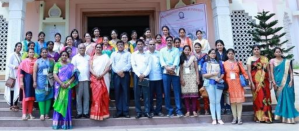 SVVU also organised four training courses of 8 days’ duration, sponsored by the Directorate of Extension, Ministry of Agriculture and Farmer’s Welfare, Govt. of India, for middle level extension functionaries covering participants representing different parts of the country. The following are the programs conducted:
SVVU also organised four training courses of 8 days’ duration, sponsored by the Directorate of Extension, Ministry of Agriculture and Farmer’s Welfare, Govt. of India, for middle level extension functionaries covering participants representing different parts of the country. The following are the programs conducted:
- Improving the core competencies of women livestock extension professionals;
- Dairy technology for non-dairy technologists;
- Role of veterinarians in one health approach: Capacity building for mitigation of emerging zoonoses and super bugs;
- Integrated farming system for livelihood security under changing climate scenario in Indian farming.
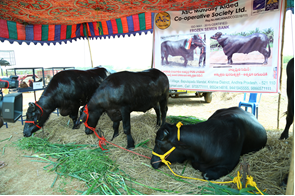 SVVU also organised a Kisan Mela at the veterinary college, Gannavaram, to expose livestock farmers on various aspects of livestock development. Various stalls – including Animal Husbandry Department, Fishery Department, Dairy Technology & Fishery colleges, insurance, machine manufacturers, KVKs and NGOs, etc., – were put up during the Mela. Sahiwal cows, Murrah buffaloes, Rajasri birds, fingerlings and fish, and Nellore jodpi attracted the attention of the visitors. Demonstrations on preparation of meat and milk products, working procedure of milking machines, etc., have attracted the farmers and created awareness on latest farming technologies. An interaction meeting and a question-answer session was conducted involving farmers during the Mela. Approximately1165 farmers visited the Mela.
SVVU also organised a Kisan Mela at the veterinary college, Gannavaram, to expose livestock farmers on various aspects of livestock development. Various stalls – including Animal Husbandry Department, Fishery Department, Dairy Technology & Fishery colleges, insurance, machine manufacturers, KVKs and NGOs, etc., – were put up during the Mela. Sahiwal cows, Murrah buffaloes, Rajasri birds, fingerlings and fish, and Nellore jodpi attracted the attention of the visitors. Demonstrations on preparation of meat and milk products, working procedure of milking machines, etc., have attracted the farmers and created awareness on latest farming technologies. An interaction meeting and a question-answer session was conducted involving farmers during the Mela. Approximately1165 farmers visited the Mela.
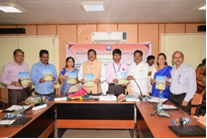 A one-day workshop on ‘Problems and Prospects of Fishery Extension Services in Andhra Pradesh – Way Forward’ was organised by the Director of Extension, SVVU, Tirupati on 28 September, 2018. Fish farmers were invited to this event and officials of the Department of Fisheries from all the 13 districts of Andhra Pradesh attended.
A one-day workshop on ‘Problems and Prospects of Fishery Extension Services in Andhra Pradesh – Way Forward’ was organised by the Director of Extension, SVVU, Tirupati on 28 September, 2018. Fish farmers were invited to this event and officials of the Department of Fisheries from all the 13 districts of Andhra Pradesh attended.
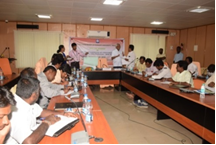 The participants of the workshop representing the state department were Joint Director (JD), Deputy Directors (DDs), Assistant Directors (ADs) of the Fishery Department; Faculty of Fishery Science of SVVU; fish farmers from different districts of Andhra Pradesh, officials from Central Institute of Freshwater Aquaculture (ICAR-CIFA), and National Fishery Development Board (NFDB). This workshop aimed at bringing all the stakeholders of fish farming on to a common platform to discuss the ways and means of improving the income of fish farmers, especially the small farmers. The workshop specifically focused on areas for capacity building of fisheries extension personnel; constraints experienced by fish farmers; and the way forward to help improve their welfare.
The participants of the workshop representing the state department were Joint Director (JD), Deputy Directors (DDs), Assistant Directors (ADs) of the Fishery Department; Faculty of Fishery Science of SVVU; fish farmers from different districts of Andhra Pradesh, officials from Central Institute of Freshwater Aquaculture (ICAR-CIFA), and National Fishery Development Board (NFDB). This workshop aimed at bringing all the stakeholders of fish farming on to a common platform to discuss the ways and means of improving the income of fish farmers, especially the small farmers. The workshop specifically focused on areas for capacity building of fisheries extension personnel; constraints experienced by fish farmers; and the way forward to help improve their welfare.
FEEDBACK/OUTCOME
The role and contribution of SVVU has been well recognised and appreciated by other stakeholders of livestock development in the state. All the extension programmes conducted by SVVU has received wide publicity through good coverage in the local dailies. Participating farmers were able to appreciate the services provided by SVVU for their benefit, and the ways and means of accessing them.
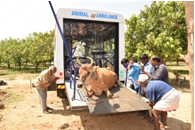 Based on the demand from livestock owners Veterinary Ambulance services were made operational through the induction of three veterinary ambulances. Livestock owners can avail of this facility to transport their sick or seriously ill animals to the nearby veterinary teaching hospital of the university by paying nominal charges. All the three colleges have this facility, which could be used by livestock owners in the concerned villages.
Based on the demand from livestock owners Veterinary Ambulance services were made operational through the induction of three veterinary ambulances. Livestock owners can avail of this facility to transport their sick or seriously ill animals to the nearby veterinary teaching hospital of the university by paying nominal charges. All the three colleges have this facility, which could be used by livestock owners in the concerned villages.
The major stakeholders in livestock development – SVVU and DAH – have recognised and realised the respective roles and the synergistic effect of coordination on livestock farmers. The officials of SVVU, DAH and other stakeholders felt the need to work in tandem to address the many problems of livestock owners. The other stakeholders who took part in the extension programmes were Department of Sheep & Goat Cooperative Federation, District Administration, KVK, pharmaceutical and vaccine production companies, etc.
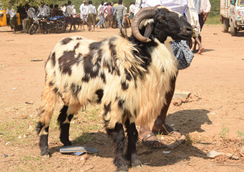 The faculty of SVVU have been sensitised to the field problems experienced by both livestock owners and field vets. The KVK, Guntur, got a shot in the arm with the organisation of Kisan Mela, which caught the attention of visitors, especially to the Macherla breed of sheep.
The faculty of SVVU have been sensitised to the field problems experienced by both livestock owners and field vets. The KVK, Guntur, got a shot in the arm with the organisation of Kisan Mela, which caught the attention of visitors, especially to the Macherla breed of sheep.
It is particularly creditable to note that SVVU is the only veterinary university in the country to be included as one of the premier institutions under Unnat Bharat Abhiyaan, a flagship extension programme initiated by the Govt. of India, for the purpose of engaging higher educational institutions in understanding and working in rural areas.
Acknowledgements: The authors are grateful to Dr Y Hari Babu, Hon’ble Vice-Chancellor, Sri Venkateswara Veterinary University (SVVU), for taking active part in all the extension activities, and providing dynamic inspiration. They are also thankful to Dr SVN Rao, Professor of Extension (Retd.), Puducherry, Director of Animal Husbandry, Andhra Pradesh; and Managing Director, Sheep Federation, Andhra Pradesh.

Dr D Sreenivasulu, Director of Extension, SVVU, Tirupati, email: desvvu@gmail.com;

Dr J Suresh, Coordinator, CCVEC, SVVU, Tirupati, email: ccvecsvvu@gmail.com;

N Sailaja, Professor, CCVEC, SVVU, Tirupati, email: ccvecsvvu@gmail.com;

Dr Dr G Triveni, Associate Professor, CVSc, SVVU, Tirupati, email: triveni04@gmail.com and

Dr D Srinivasa Rao, T.O to D.E, SVVU, Tirupati, email: srddasari@gmail.com.


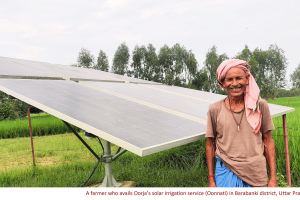
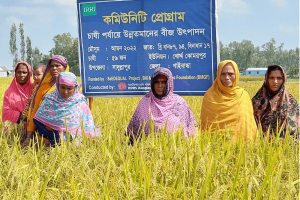
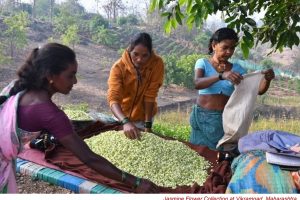
Good effort to devise the livestock extension strategy in coordination with other agencies involved in the development of the livestock sector